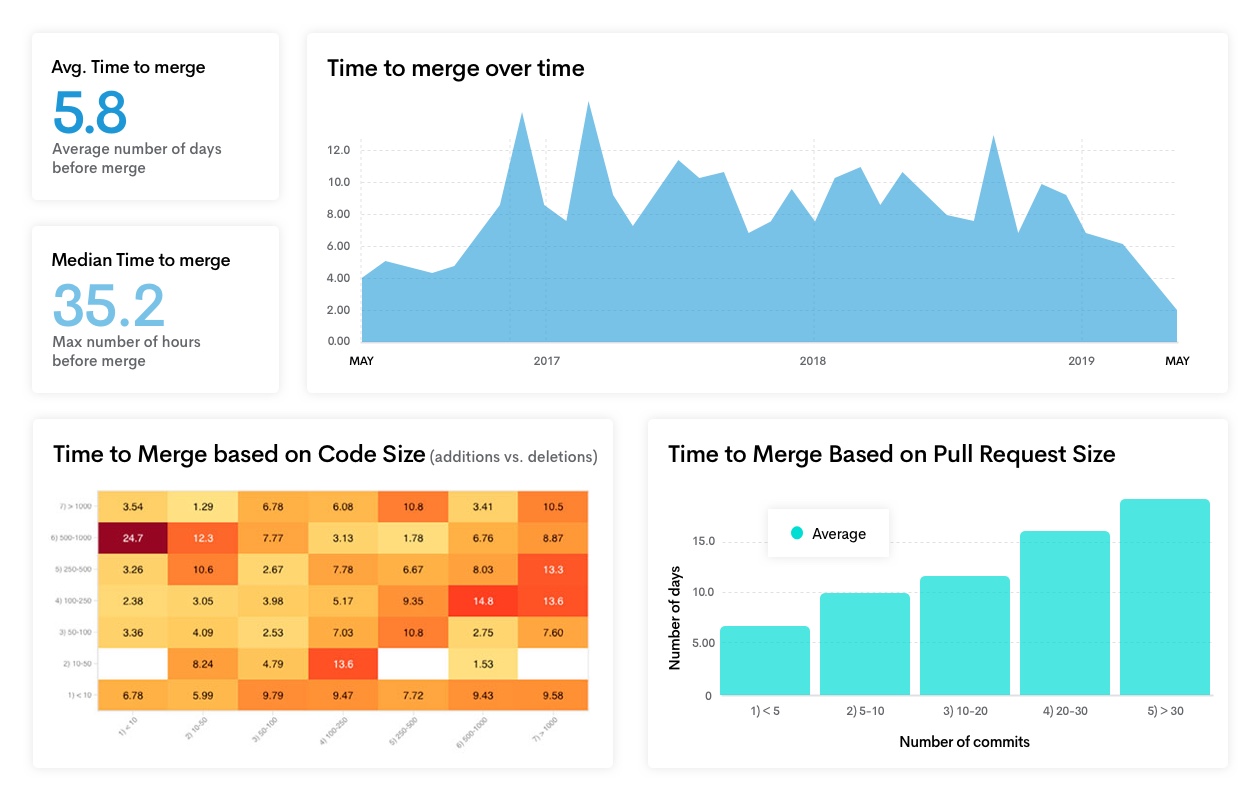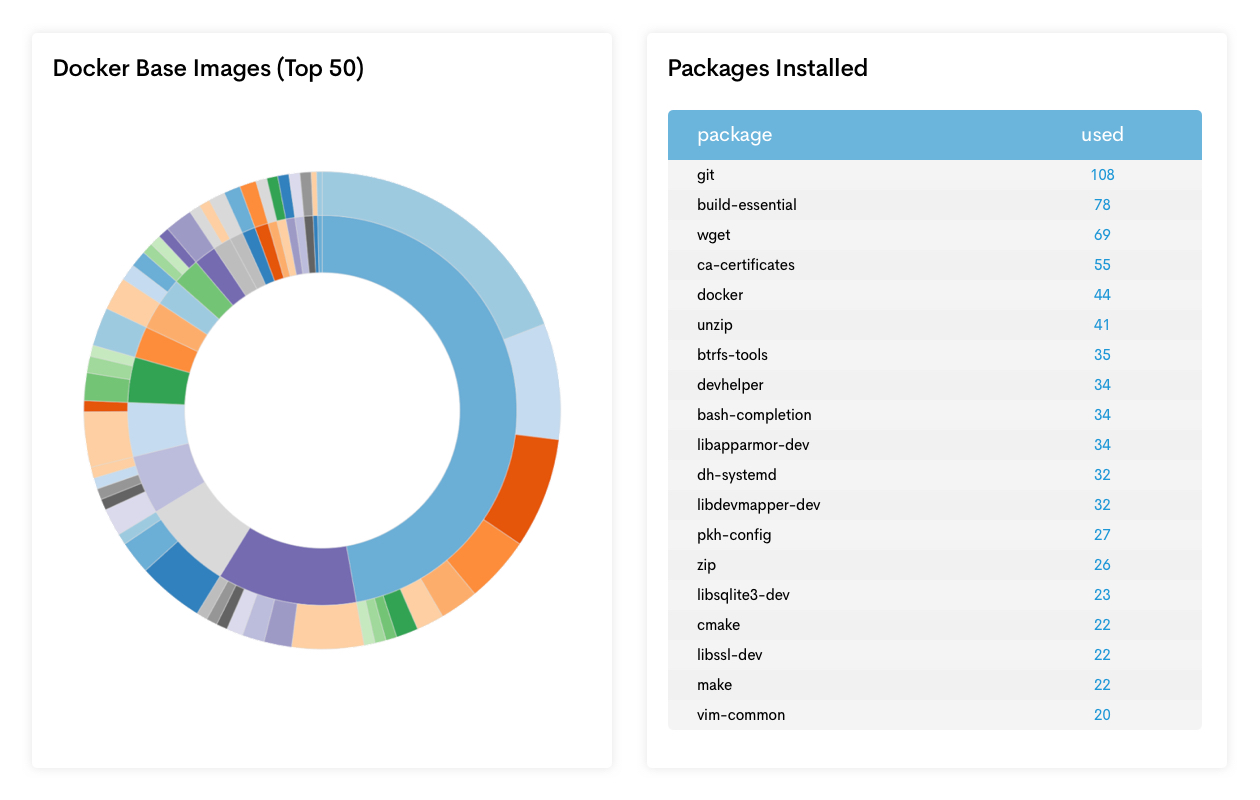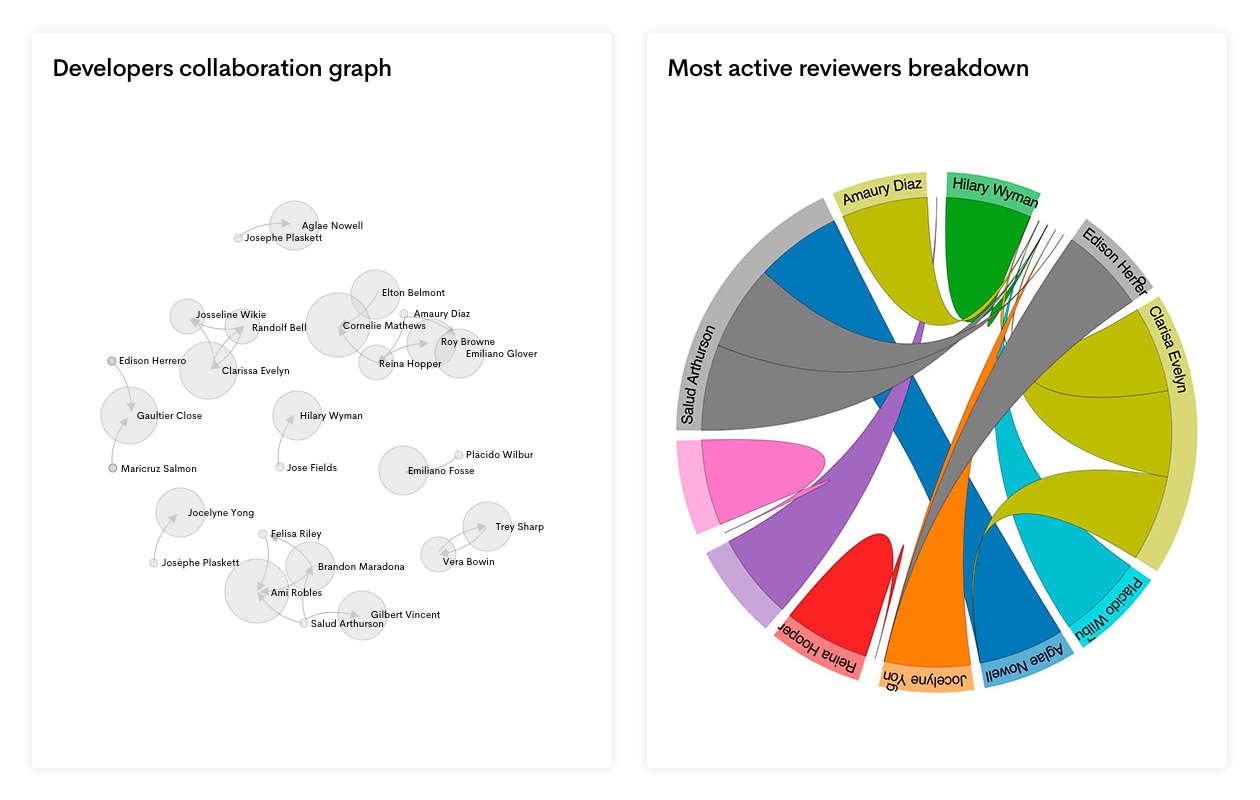Podimo raises €6M to become Europe’s ‘Netflix for podcasts’
Podimo, a Copenhagen-based startup building what it hopes will become Europe’s “Netflix for podcasts,” has raised €6 million in seed funding prior to launch. The round is co-led by Germany’s E.ventures and Denmark’s Heartcore, reflecting the young company’s two planned country launches later this year.
Founded by Morten Strunge, who has a track record in subscription media products via audio books service Mofibo (which he sold to Storytel), Podimo is hoping to capitalise on the rise in consumption in podcasts. Ambitiously, this will include both a free and paid version of its product, with the aim of creating a reliable revenue stream for podcast producers. The startup’s other founders are Nikolaj Koppel, Andreas Sachse and Sverre Dueholm.
“Podcasts have finally come of age and we are seeing a lot of demand for audio content globally across many different demographics,” Strunge tells me. “Consumers are increasingly looking for premium, ad-free services and we see a huge potential in the podcasting space.”
The Podimo app has been designed to provide a “superior experience” in discovery and recommendation compared to existing podcast streaming and download services. The idea, says Strunge, is to make it as seamless and easy as possible to find your next podcast.
“We believe that with the fast increasing amount of podcasts available, curation and discovery becomes more and more important to both unfold content in a relevant context and to the right individual user, which will benefit both podcast creators and consumers,” he says.
By launching a freemium model, where a paid version provides unlimited listening and features, Strunge believes there is an opportunity to work closely with podcast creators to strengthen the podcast ecosystem and make it less reliant on advertising revenue. “We want to become the preferred partner for creators, by both working closely with their content, curate and match it with each individual user, but also by offering a superior monetisation model,” he explains.
The hope then is that a more robust revenue stream will enable new podcasters to enter the market and allow existing ones to earn more. In turn that could give podcasters the financial headroom to invest even more time and effort into “creating great content.”
“Our dream is that with around 20% of people in Europe listening to podcasts on a weekly basis, many creators should be able to make a living out of creating podcasts, it shouldn’t just be for the few,” says Strunge, perhaps ignoring the fact that media often scales to become a hits-driven business. “We will offer revenue share to all existing podcasters out there, but also co-produce and produce original content,” he adds.
More broadly, Strunge says he remains a strong believer in audio as a format. He says not only is it easier to listen than it is to read but that podcasts are built for subscriptions. “It’s a short format, actuality driven, series driven and niche and broad at the same time,” says the Podimo CEO.
In addition, production costs are low so it’s possible to keep to a price point below music and VOD services, and Strunge is convinced we will continue to see a significant increase in the number of podcasts produced. This will include the broader market, but also podcasts from more professional media players yet to invest strategically in the audio format.
Powered by WPeMatico
TikTok is being investigated in the UK for how it handles children’s data and safety
TikTok is being investigated in the U.K. for how it handles the safety and personal data of underage users. According to The Guardian, information commissioner Elizabeth Denham told a parliamentary committee that the probe started in February after the U.S. Federal Trade Commission levied a $5.7 million fine against TikTok for breaking children’s privacy law.
Denham told The Guardian that the commission is examining how TikTok collects private data and has concerns about the open messaging system, which may allow adult users to contact children. “We are looking at the transparency tools for children. We’re looking at the messaging system, which is completely open, we’re looking at the kind of videos that are collected and shared by children online. We do have an active investigation into TikTok right now, so watch this space,” she said.
The investigation will also examine if the popular app, owned by ByteDance, violates the General Data Protection Regulation (GDPR), which requires companies to put special protections in place for underage users and provide them with different services than adults.
The FTC’s investigation, which began when TikTok was still known as Musical.ly, ruled that the app broke the Children’s Online Privacy Protection Act by failing to seek parental consent before collecting names, email addresses and other personal information from users under 13. The ruling resulted in an age gate being added to an app that prevents users under 13 from filming and posting videos on it.
ByteDance, the Chinese media startup now valued at $75 billion, told The Guardian in a statement that “We cooperate with organizations such as the ICO to provide relevant information about our product to support their work. Ensuring data protection principles are upheld is a top priority for TikTok.”
Powered by WPeMatico
Kyash, a would-be challenger bank in Japan, raises $14M
The new era of tech-enabled banks is coming, even in regulation-heavy Japan. Kyash, a fintech company with visions on becoming Japan’s first challenger bank, said today it has raised $14 million to continue its expansion.
To be clear, Kyash isn’t a bank. Yet. But it is currently applying for a host of licenses in Japan that could allow it to offer banking-style features, including checking accounts, ATM withdrawals and money remittance. Right now, it is a payment app that offers a connected Visa card in the style of Monzo, N26, Revolut (which has a Japan license) and others of that ilk.
The startup was founded in 2015 by Shinichi Takatori, a former banker and management consultant who saw the potential to merge tech and finance.
“I really noticed that information and communication has become ubiquitous but money itself hasn’t changed for a long time,” Takatori told TechCrunch in an interview.
The company took some time — two years — before it released a consumer product, but it quickly tied up with Visa to offer a prepaid debit card that connects to the Kyash app. That provides benefits like instant payment notifications, clear balance and lower fees for overseas spending, while costs are borne by merchants rather than users. They might seem elementary today, but they are still not standard among Japan’s traditional banks, Takatori explained.
The company declined to share its user numbers, but Takatori said this new round of funding — Kyash’s Series B — is a validation of the progress it has made.
The $14 million investment is co-led by Goodwater Capital, a U.S. investor that has backed fintech startups like Monzo, Stash and Toss in Korea, and Mitsubishi UFJ Capital, the investment arm of Japan’s largest bank.
Mitsubishi’s involvement means that Kyash counts Japan’s three largest banks as investors, with SMBC and Mizuho having previously put money into the company. Others that took part in this Series B include Toppan Printing, JAFCO and Shinsei Corporate Investment Limited.
So many banks on the cap table might seem like a strange thing for a disruptor — let alone the banks, which tend to behave territorially — but Takatori believes that there’s the potential for cooperation, not to mention that it will help the startup with its licensing efforts. Already, he revealed, Mitsubishi plans to integrate its card with the Kyash app to provide its customers with the best of both worlds.
“We’re not here to win over existing banks, but instead inform [them of] how money should work in next decade,” explained Takatori. “So why not collaborate in some way.”

Kyash has a tie-up with Visa that allows it to offer its customers a connected debit card and also provide issuing services to other fintech startups
There’s also the fact that, even with a license, Kyash and others are unlikely to be able to offer full banking services. That means they will have to serve as complementary offerings to the industry, which would likely mean that cooperation is good — essential — for both sides.
But, beyond the consumer play, a notable piece of Kyash’s business that has investors excited is its B2B payment business.
The company developed its own payment processing system to reduce costs, which is one reason it took time to launch. Thanks to a tie-up with Visa, it offers both issuing and processing of prepaid Visa cards to fintech companies in Japan that want to go down the payment route.
That’s increasingly popular, given the government push to make the country a “cashless society” ahead of the 2020 Olympic Games next year. It also could appeal to crypto companies in Japan, which offers the world’s most robust licensing, that want to follow the example of the Coinbase card in Europe or startups like Crypto.com and TenX, which offer similar prepaid cards.
Takatori said Kyash is “in discussions” with crypto companies, but that it has not made a decision on how to proceed yet. The company is also eyeing potential overseas expansions, although that is some way down the line.
“We have open eyes for globalization, it’s just a matter of when,” he told TechCrunch. “We still have a far way to go [in Japan, but] maybe after the Olympics.”
More pressingly, he sees the company looking to raise a “pretty quick” Series C round to give it acceleration into next year. That’s likely to go to more expansion and user acquisition as the licenses the startup has applied for are unlikely to be granted this year.
Powered by WPeMatico
Samsung will announce the next Galaxy Note on August 7
It’s official. Samsung just sent out invites for the next Unpacked event. The big show kicks off at 4PM ET August 7, right here in New York. The timing lines up with rumors that have been floating around for a few weeks — not to mention last year’s big event.
And in case there was any mystery around what precisely the company is going to unveil, Samsung has happily spoiled the surprise with the inclusion of a prominent S Pen on the invite. The August event will almost certainly see the debut of the Galaxy Note 10.
The art appears to hint at an updated camera, as well. Based on recent leaks, the invite looks to be a close-up of the nearly all-screen front of the new phablet, with the single hole punch front-facing camera up top. The new handset is said to include a vertical three-array camera with depth sensing and a 5G option. Samsung is also reportedly dropping the headphone jack this time out, after years pointing to it as a standout feature from the rest of the industry.
Last year’s event also saw a number of additional devices, including the (still unreleased) Galaxy Home smart speaker. At the very least maybe we’ll finally be getting a date on that product, along with more information about the long-delayed Galaxy Fold.
Powered by WPeMatico
KKR has acquired Corel (including its recent acquisition Parallels), reportedly for $1B+
Only six months after snapping up virtualization specialist Parallels, Canadian software company Corel is itself getting acquired. TechCrunch has learned and confirmed with multiple sources that private equity giant KKR has closed a deal to buy the company from Vector Capital, which has owned some or all of Corel since 2003.
KKR’s interest in Corel was first rumored in May, when PE Hub reported the two were in talks for a sale valued at over $1 billion. At the time, representatives of Corel declined to comment, although our sources inside the company indicated that the reports were not inaccurate.
Fast-forward to today, and both KKR and and a spokesperson for Parallels/Corel declined to comment. But, we now have a copy of the memo provided by an internal source that has been sent out to staff announcing that the deal has indeed closed, and that Corel is now officially part of the KKR family of companies.
According to the memo, KKR is very optimistic about Corel’s prospects. It plans to give Corel an “infusion of capital” to accelerate its growth, which will go into two areas. First will be expanding operations for the existing business: Corel is the company behind a number of longstanding software brands including WordPerfect, Corel Draw, WinZip, PaintShop Pro. Second will be making acquisitions (and the sheer proliferation of promising startups in the last decade dedicated to all variety of apps and other software that may have found it a challenge to scale means Corel could have rich pickings).
There are no layoffs planned as part of the deal, and the official announcement had been planned to go out next week, but now looks like it may be moved up to tomorrow (Wednesday).
Vector and Corel itself have never publicly disclosed much on user numbers or financials, but Vector has described the company as “highly profitable,” with dividends of more than $300 million to date. The memo we’ve seen notes that Corel (including Parallels) has millions of customers across its various software platforms and apps.
The acquisition of Corel by KKR marks another chapter in the company’s long corporate history.
Founded in the 1980s — when personal computers were just starting to enter the mainstream but well before we had anything like the internet (not to mention the world of cloud-based apps) that we know today — Corel once positioned itself as a potential competitor to Microsoft in the software wars.
When Corel purchased WordPerfect from Novel in 1996, Corel founder Michael Cowpland viewed the software package as an integral part of that rivalry, describing it as the Pepsi to Microsoft’s Coke — that is, Word.
Microsoft proved the mightier of the two, and it even eventually signed a partnership with Corel that saw it investing in the company: a sell out, as one disappointed Canadian journalist described it at the time. The two have also sparred over patents.
Corel, which went public early in its life, got battered in the first dot-com bust (which was not helped by an insider trading scandal that led to Cowpland’s departure). Vector stepped in and took it private in 2003.
After restructuring the company, Vector listed Corel again in 2006. But, amid another recession that again hit Corel hard, it once more took it private in 2010. In the intervening years, Corel has been focused on modernising its offerings, bringing in e-commerce, direct downloads, subscriptions and acquisitions to bring the company’s products and wider business closer to how consumers and workers use computers today.
Parallels was a part of that strategy: its products help people work seamlessly across multiple platforms, letting employees (and IT managers) run a unified workflow regardless of the device or operating system, with Parallels providing support for Windows, Mac, iOS, Android, Chromebook, Linux, Raspberry Pi and cloud — a timely offering in the current, fragmented IT market.
If the $1 billion+ figure is accurate, that strategy seems to have worked: across the two times that Vector took Corel private, it never paid more than $124 million for the company (the second time, as its stock was tanking, it paid just $30 million).
Powered by WPeMatico
Uber Eats invades restaurants with Dine-In option
Tired of cleaning up after take-out or getting hangry waiting at your table in restaurants? Well Uber Eats is barging into the dine-in business. A new option in some cities lets you order your food ahead of time, go to the restaurant, then sit down inside to eat, a tipster from competing dine-in app Allset tells us. We tested it, and Uber Eats Dine-In even waives the standard Uber delivery and service fees.
Adding Dine-In lets Uber Eats insert itself into more food transactions, expand to restaurants that care about presentation and don’t do delivery and avoid paying drivers while earning low-overhead revenue. Uber’s Dine-In option is now available in some cities, including Austin, Dallas, Phoenix and San Diego, where it could save diners time and fees while helping restaurants fill empty tables and waiters earn tips. But it also could coerce more restaurants to play ball with UberEats if their competitors do, eating into their margins.
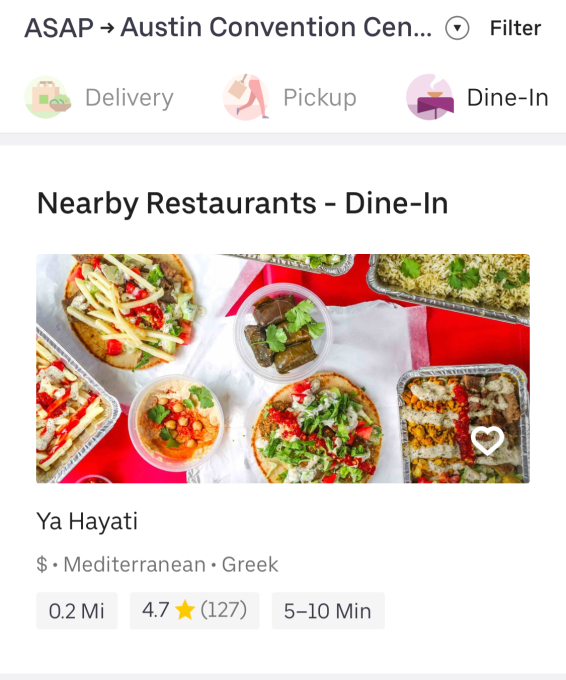
Uber confirmed the existence of the Dine-In option, telling me, “We’re always thinking about new ways to enhance the Eats experience.” They also verified there are no delivery or service fees, and restaurants get 100% of tips left in-app by users. However, we found some items were silently marked up from restaurants’ listed prices in both Uber Eats Delivery and Dine-In options, which could help it make some money directly from these purchases. We also discovered this buried Uber Help Center FAQ with more details.
Uber has been rapidly experimenting with Uber Eats, trying discounted specials, Uber Eats Pool, where you pay less for slower delivery, and $9.99 unlimited delivery subscriptions. It’s steadily becoming an omnivore.
How Uber Dine-In Works
Dine-in appears next to the Delivery and Pick-Up options across the top of the Uber Eats app in select cities. You can choose to go eat “ASAP” or in some cases schedule when you want to arrive and sit down. You’ll be shown how long the food will take to prep, distance to the restaurant, your price and the restaurant’s rating. You’ll then be notified as the order is prepared and approaches readiness. Then you just deliver yourself to the restaurant and add a tip in-app or on the table.
Uber Eats should obviously make it easy for you to hail an Uber with the restaurant as the pre-set destination. An Uber spokesperson called that a good idea but not something it’s doing yet. Back in 2016, Uber tried a merchant-sponsored rides option where you’d get a rebate on your travel if you spent money at a given store. You could imagine restaurants that want to show off their ambiance giving customers some money back if they come across town to eat there.
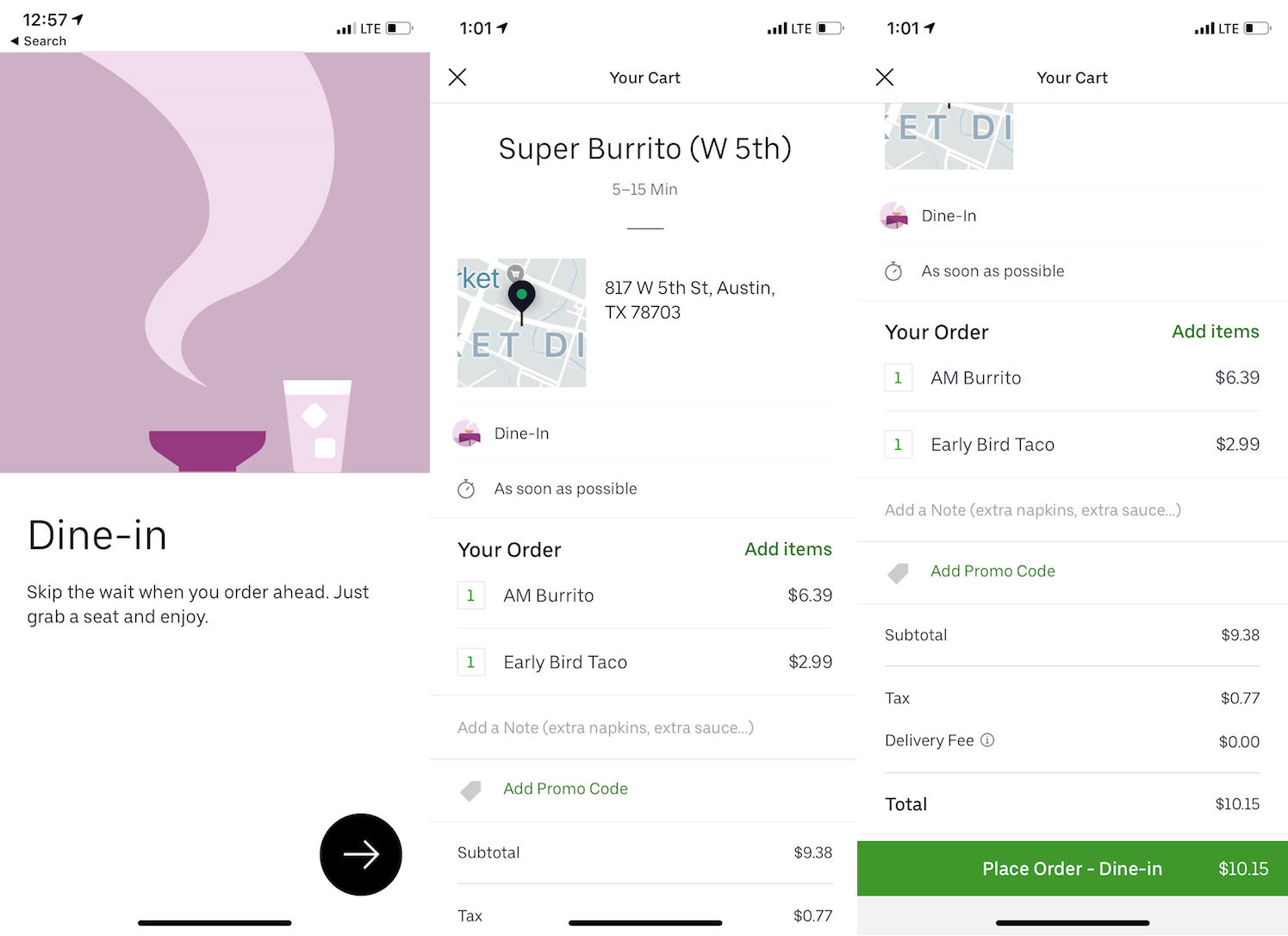
The new feature could spell trouble for other dine-in apps like Allset that’s been in the business for four years. Users might also opt for Uber Eats Dine-In over restaurant reservation apps like OpenTable and Resy. Why waste time waiting to order and for your food to be cooked when you could just show up as it comes out of the oven?
“I think that more delivery players will be tapping into dine-in space. It’s all about convenience and time saving. But it’s going to be very difficult for them, given their focus on delivery,” Allset CEO Stas Matviyenko said of Uber becoming a competitor. He believes dedicated apps for different modes of dining will succeed. But Uber Eats’ ubiquity and its one-stop-shop model for all your dining needs could make it stickier than a dine-in only app you use less frequently.

With Dine-In, Uber could aid restaurants that are empty at the start or end of their open hours. Last year we reported that Uber Eats was giving restaurants prominence in a Featured section of the app to drive up demand if they offered discounts to customers. Similarly, Uber could let restaurants entice more Dine-In customers, especially when foot-traffic was slow, by providing discounts on food or subsidized Uber transportation. Better to knock a dollar or two off an entree if it means filling the restaurant at 5:30 or 9:30 pm.
And now that Uber Eats does delivery, take-out and dine-in, it’d make perfect sense to offer traditional restaurant reservations through the app as well. That would pit it directly against OpenTable, Resy and Yelp. Instead of trying to own a single use case that might only appeal to certain demographics in certain situations, Uber Eats’ strategy is crystallizing: be the app you open whenever you’re hungry.
Powered by WPeMatico
Demo your startup at TC Sessions: Enterprise 2019
Every year hundreds of startups launch with dreams of becoming the next enterprise software unicorn. And it’s no wonder, given the $500 billion market and the rate at which the enterprise giants snap up emerging players. If you’re the founder of an early-stage enterprise startup, join us for TC Sessions: Enterprise in San Francisco on September 5 at the Yerba Buena Center for the Arts.
Even better, grab the opportunity by the horns and buy a Startup Demo Package. There is limited space available. This is your chance to plant your company in front of some of the most influential enterprise movers and shakers — we’re talking more than 1,000 attendees. Demo tables are reserved for startups with less than $3 million in funding and are available for $2,000, which includes four tickets to the event.
This day-long intensive event features speakers, panel discussions, demos, workshops and world-class networking. Get ready for a head-on, hype-free exploration of the considerable challenges enterprise companies face — regardless of their size.
TechCrunch editors will interview founders and leaders from both established and up-and-coming companies on topics ranging from intelligent marketing automation and the cloud to machine learning and AI. And they’ll question enterprise-focused VCs about where they’re directing their early, middle and late-stage investments.
The full roster of speakers is still to be announced, but here’s a quick hit of who you can expect at TC Sessions: Enterprise.
You’ll hear from Scott Farquhar, co-founder and co-CEO of Atlassian, a company that’s changed the way developers work. Want to hear more about enterprise and the cloud? Snowflake’s co-founder and president of product, Benoit Dageville, will be on hand to talk about the company’s mission to bring the enterprise database to the cloud.
Have someone you want to hear from our stage? Submit your speaker suggestion here.
Pro Tip: For each TC Sessions: Enterprise ticket you buy, we’ll register you for a complimentary Expo Only pass to TechCrunch Disrupt SF on October 2-4.
TC Sessions: Enterprise takes place September 5 at San Francisco’s Yerba Buena Center for the Arts. Don’t miss this opportunity to showcase your early-stage enterprise startup in front of leading enterprise software founders, investors and technologists. Buy your Startup Demo Package today.
Looking for sponsorship opportunities? Contact our TechCrunch team to learn about the benefits associated with sponsoring TC Sessions: Enterprise 2019.
Powered by WPeMatico
Sam Lessin and Andrew Kortina on their voice assistant’s workplace pivot
Sam Lessin, a former product management executive at Facebook and old friend to Mark Zuckerberg, incorporated his latest startup under the name “Fin Exploration Company.”
Why? Well, because he wanted to explore. The company — co-founded alongside Andrew Kortina, best known for launching the successful payments app Venmo — was conceived as a consumer voice assistant in 2015 after the two entrepreneurs realized the impact 24/7 access to a virtual assistant would have on their digital to-do lists.
The thing is, developing an AI assistant capable of booking flights, arranging trips, teaching users how to play poker, identifying places to purchase specific items for a birthday party and answering wide-ranging zany questions like “can you look up a place where I can milk a goat?” requires a whole lot more human power than one might think. Capital-intensive and hard-to-scale, an app for “instantly offloading” chores wasn’t the best business. Neither Lessin nor Kortina will admit to failure, but Fin‘s excursion into B2B enterprise software eight months ago suggests the assistant technology wasn’t a billion-dollar idea.
Staying true to its name, the Fin Exploration Company is exploring again.
Powered by WPeMatico
Netflix’s ‘Stranger Things’ comes to Roblox ahead of its July 4 premiere
Netflix is bringing its hit TV show Stranger Things to Roblox. On Monday, Roblox announced the launch of limited-time, Stranger Things-themed items that will be made available to its more than 90 million players, who can earn them by solving daily riddles and puzzles. Other free, limited-time items like a “Scoops Ahoy” hat and Demogorgon mask will also be offered as virtual items for players’ Roblox avatars.
The first of the two themed items are live now and will be free to download through July 12. Four more items can be unlocked by solving daily riddles and puzzles, with a new clue arriving each day ahead of the July 4 premiere of Stranger Things Season 3.
Roblox will also share clues across its social media accounts on Facebook, Twitter and Instagram, it says.
What’s interesting about the Roblox integration is that it may reach children younger than those ages 14 and up — the ages that the series itself is rated for (TV-14). (Likely, some braver tweens are already familiar with the show and are watching alongside mom or dad… or at least with their approval.)
However, the Roblox partnership is only one of several gaming-focused initiatives Netflix has planned to market some of its most anticipated programming, including both Stranger Things and other titles.
To unlock Eleven’s Mall Outfit from @Stranger_Things, you’ll need to learn the score. Check our Facebook and Instagram pages for more clues and solve today’s puzzle before July 18th! https://t.co/y78FWxfQUn pic.twitter.com/DYSqhTPoH3
— Roblox (@Roblox) July 2, 2019
At this year’s E3, Netflix detailed a series of gaming initiatives, including integrations with partners like Ubisoft, Behavior Interactive and even Fortnite, in addition to Roblox. Already, some Fortnite players had found the “Scoops Ahoy” Easter egg back when Season 9 launched, Netflix said.
Plus, the company is preparing not one but two new Stranger Things-themed games. The first, called Stranger Things 3: The Game, will launch across platforms including Nintendo Switch, Xbox One, PlayStation 4, PC, Mac, Android and iOS on the same day the third season premieres. Like its predecessor, also by developer BonusXP, the game is meant to be a companion to the current season and features 16-bit action for a nostalgic feel.
Next year, Netflix is planning another new Stranger Things title, with a mobile game for iOS and Android. This one is a location-based RPG/puzzler where players explore The Upside Down hidden all around them, while working with other players to “overcome its emerging evils.”
Netflix is also preparing to launch on Nintendo Switch, Xbox One, PlayStation 4, PC and Mac a turn-based tactics game adapted from the Netflix Original series The Dark Crystal: Age of Resistance.
A wave of digital marketing isn’t entirely new for the streaming service.
In the past, it toyed with mobile experiences to advertise its shows — like the standalone Orange is the New Black app it launched back in 2014, or the “FakeBlock” app introduced to advertise the new season of Arrested Development.
The company also toyed around with a cross between games and TV with the 2018 launch of Minecraft: Story Mode, which some could consider a form of gaming. Netflix, however, did not. It even claimed at the time that the company did not have any plans “to get into gaming.”
Well, that’s no longer true.
While many of the integrations and games themselves are built by partnered developers, Netflix is clearly involved. And unlike the throwaway apps from years prior, these are more series efforts on Netflix’s part — not just promotional vehicles for its shows.
The marketing doesn’t stop at digital games either.
Netflix’s Stranger Things is more than just a show, it’s a whole business unto itself. It’s Baskin-Robbins ice cream flavors, and Target exclusives like a Stranger Things bike, toys and apparel. It’s posters, games and all kinds of other merch, too. And that’s just one show. An analyst previously said Netflix’s merch biz could be a billion-dollar addition to the company’s revenue.
Beyond gaming and other stuff to buy, the Stranger Things empire extends to brand deals with Coke, Levi’s, H&M, Nike, Eggo, Schwinn, Trivial Pursuit, Burger King and more.
The Roblox and Fortnite integrations are live now. The Season 3-themed game arrives July 4.
Powered by WPeMatico
Software development analytics platform Sourced launches an enterprise edition
Sourced, or source{d}, as the company styles its name, provides developers and IT departments with deeper analytics into their software development life cycle. It analyzes codebases, offers data about which APIs are being used and provides general information about developer productivity and other metrics. Today, Sourced is officially launching its Enterprise Edition, which gives IT departments and executives a number of advanced tools for managing their software portfolios and the processes they use to create them.
“Sourced enables large engineering organizations to better monitor, measure and manage their IT initiatives by providing a platform that empowers IT leaders with actionable data,” said the company’s CEO Eiso Kant. “The release of Sourced Enterprise is a major milestone towards proper engineering observability of the entire software development life cycle in enterprises.”
Because it’s one of the hallmarks of every good enterprise tools, it’s no surprise that Sourced Enterprise also offers features like role-based access control and other security features, as well as dedicated support and SLAs. IT departments also can run the service on-premise, or use it as a SaaS product.
The company also tells me that the enterprise version can handle larger codebases so that even complex queries over a large data set only takes a few seconds (or minutes if it’s a really large codebase). To create these complex queries, the enterprise edition includes a number of add-ons to allow users to create these advanced queries. “These are available upon request and tailored to help enterprises overcome specific challenges that often rely on machine learning capabilities, such as identity matching or code duplication analysis,” the company says.
The service integrates with most commonly used project management and business intelligence tools, but it also ships with Apache Superset, an open-source business intelligence application that offers built-in data visualization capabilities.
These visualization capabilities are also now part of the Sourced Community Edition, which is now available in private beta.
“Sourced Enterprise gave us valuable insights into the Cloud Foundry codebase evolution, development patterns, trends and dependencies, all presented in easy-to-digest dashboards,” said Chip Childers, the CTO of the open-source Cloud Foundry Foundation, which tested the Enterprise Edition ahead of its launch. “If you really want to understand what’s going on in your codebase and engineering department, Sourced is the way to go.”
To date, the company has raised $10 million from First VC, Heartcore Capital, Xavier Niel and others.
Powered by WPeMatico


